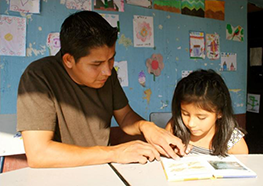
Empowering local partners through local support.
J&A’s development approach is based on a simple and clear formula: finance early childhood education, educate girls through at least the 3rd grade, provide developing countries with reproductive health services and partner, partner, partner with host country nationals. To achieve these goals, which are consistent with USAID Forward, J&A has always provided technical assistance in partnerships with USAID Bureaus, Missions and local institutions. Our approach guarantees commitment from country stakeholders with whom we work. Development is about bringing resources to bear to support advancement in sustainable ways.
Sustainable development is based on shared goals and efforts, working with all levels of society: host governments, community groups, the private sector and families. Partnerships with and between local public and private sectors (PPPs) are empowering and essential for sustaining programs that result in well-educated workers. Businesses and corporations play an increasingly important role in developing, executing and scaling up education initiatives. PPPs can provide financing and in-kind contributions far exceeding, at times, what governments can contribute. Alliances make it possible to expand the scope and impact of our activities and speed up implementation of innovations, as well as reduce resistance to change. Partnerships strengthen leadership and managerial performance. Without these parallel and synergistic efforts, improved performance may not occur. Partnerships contribute to contextual readiness for change, a requirement for sustainability of any initiative.
Sincerely,
Nicandro F. Juárez, Founder and President of J&A
Developing Local Talent through Partnerships with Government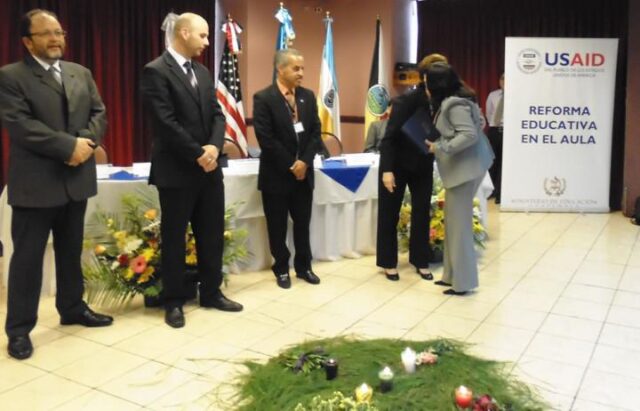
Supporting the Ministry of Education, USAID/Guatemala’s REAULA project concluded the first phase of a graduate teacher training program for 197 project scholarship awardees. The course, aimed at teachers in five municipalities in Totonicapan, was implemented by the University Rafael Landivar to strengthen teacher literacy skills in K’iche and Spanish. The graduation ceremony was held on February 13, 2013, with the participation of Fernando Rubio, REAULA Director, Juan Luis Cordova, USAID/Guatemala’s Health Information and Education officer, and Hilda Mazariegos, Dean of the Faculty of Humanities of the University Rafael Landivar.
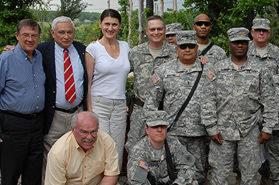 Developing Local Talent through Partnerships with Government
Developing Local Talent through Partnerships with Government
USAID’s projects in Kosovo focus on economic growth, democracy and governance to help achieve lasting security and stability. Strengthening rule-of-law, good governance, decentralization and democracy depend on an effective public education system that fosters civic development and participation. J&A worked with the government of Kosovo on a comprehensive analysis of its education sector and identified gaps and weaknesses in programs being undertaken. The project helped to identify strategies needed to ensure students graduate from school to play a meaningful role in Kosovo’s future development.
J&A is currently assessing the impact and success factors of Room to Read (RtR), a library program in developing countries. In association with local communities, RtR has established libraries and computer labs, created local language children’s literature, constructed schools and provided educational opportunities for girls and boys in numerous countries in Asia and Africa. The focus of the evaluation is on assessing the impact and success factors of the program on stimulating the development of a culture of reading in children, so as to inform program design and implementation in order for RtR to better capitalize on successes and target remaining gaps in implementation. Under this project, J&A is training numerous local evaluators to work on the project and providing them with updated skills that will be important for their future professional development.
Early Childhood Education and Development
By Alfredo Artiles, PhD1 A recurring question in development policy is, “why should governments invest in early childhood education programs?” Although there are many important reasons, perhaps the most persuasive is that investment in the education of children in the first six years of life has a positive impact on the development of the entire population and the nation. For this reason, it is paradoxical that the level of support for such programs is still unacceptably low, especially in developing countries. An important premise in early childhood education is that children experience critical changes in the first six years of life as the foundations for future development are established in key areas such as language, cognition, socio-emotional skills and dispositions. Thus, early childhood education plays a primary role in promoting and nurturing these complex developmental processes and subsequently, the neglect or lack of stimulation in this learning. A wealth of evidence suggests that that critical period of childhood has long-term intellectual and socio-emotional consequences in children. Moreover, there is evidence of developmental gaps between children with different levels of access and participation in early childhood education (Nores & Barnett, 2010). As well, a key message in this literature is that programs must be contextually relevant and respond adequately to the characteristics and needs of local communities (OECD, 2006). In the case of countries like Guatemala, where the cultural and linguistic diversity of the population defines national identity, this requirement is essential. In general, research on effective early childhood education suggests the following (Barnett, 2008; EFA, 2007): Integrate educational activities with services in other sectors such as health, nutrition and communitybased care. Relatively few countries have developed frame-works that offer this integrated perspective, and even fewer have established mechanisms and processes to coordinate services across sectors. Support and education for parents or guardians. This is particularly important for children from 0-3 years, given the importance of the home environment in the emotional and intellectual development of children. Coordinate the transition to primary school.
Early Childhood Education and Development
- Include vulnerable groups such as children living in poverty, living in conflict areas, having special needs and/or disabilities. Investments in programs for vulnerable groups of 0 – 3 years have been shown to yield higher returns.
- Provide opportunities for girls and boys to individually develop their own learning processes and explore their surrounding environments with age-appropriate activities.
- Include ongoing programs for staff professional development.
The OECD Report (2006), “Starting Strong II: Early Childhood Education and Care,” provides useful guidance for international programs in early childhood development.
Alfredo J. Artiles is a Ryan C. Harris Professor of Special Education at Arizona State University. His scholarship examines the ways culture and ideologies of difference mediate school responses to students’ needs. He was Vice President of the American Educational Research Association (AERA) (2009-2011). He is a Commissioner in President Obama’s Advisory Commission on Educational Excellence for Hispanics. View full article publication in Spanish, at:
http://www.reaula.org/administrador/files/Educacion%20I nicial%20y%20Preprimaria.pdf
Nores, M., & Barnett, W. S. (2010). Benefits of early childhood interventions across the world: (Under) investing in the very young. Economics of Education Review, 29, 271-282.
Barnett, W. S. (2008). Preschool education and its lasting effects: Research and policy implications. Boulder and Tempe: Education and the Public Interest Center & Education Policy Research Unit. Retrieved September 1, 2010 from http://epicpolicy.org/publication/preschooleducation.
Education for All Global Monitoring Report (EFA 2007). Early childhood. Oxford, UK: UNESCO Publishing /Oxford University Press.
Working with Private Sector Partners to Support Education

The Jamaica National Building Society (JNBS) again underlined its reputation as one of Jamaica’s leading corporate supporters of education by its donation of books to be used by children at J&A/USAID Jamaica Basic Education project, Camp Summer Plus. The Camp is a program designed to help underperforming students advance reading skills during the summer months. Sales Development Specialist at JNBS, Alicia Young, handed over the material at the official launch of the camp in 2012.
News Flash: Technology boosts performance in early grade reading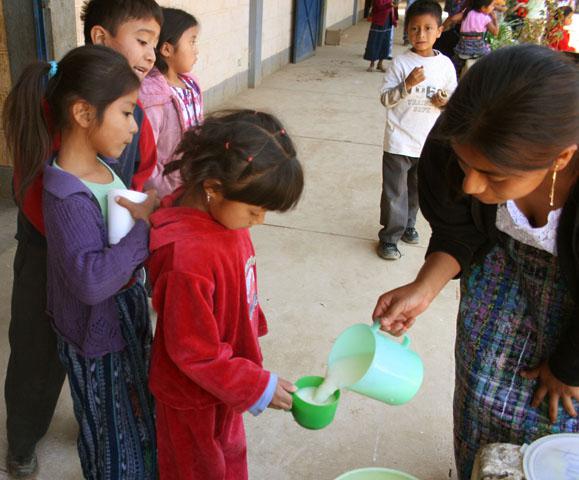
SCORES of early grade teachers in select schools across the country have been embracing the challenge and opportunity to use emerging technologies to improve instruction in reading. Since the start of the 2012/2013 academic year, select primary schools from regions one, four and six in the US Agency for International Development (USAID)/Jamaica Basic Education Project have seen improvements in reading performances for children in grades one to three. The joint initiative between USAID and the Ministry of Education has utilised information and communications
technology (ICT) to help USAID in the roll-out of its reading strategy in 172 primary schools. ICT Advisor on the Project Dr. Melody Williams said during the current academic year, the teachers and students have been excited about the use of technology to boost reading levels. “One of the things which we have been pleased about is the response of the leadership in the project schools. Board chairmen, principals and vice principals have responded positively and this had filtered down to the teachers, who have been using the ICT strategies to enhance their reading programmes.”
View All Articles in One PDF
Partnering With Families ―“Parent Schools”
The USAID/Guatemala REAULA social communication component implements a model for educating the local community to support a better quality of education for its students, particularly with a focus on reading in the early grades and girls’ performance. The development of the parent education program is part of this outreach model. Tailored programs are based on needs assessments conducted in project communities in El Quiché, Chiquimula and Jalapa using focus groups and interviews with key actors. The program provides direct instruction to parents on how to engage children in reading and has three goals:
1. To sensitize parents whose children are enrolled in first, second and third grades about the importance of participating in their education.
2. To persuade parents about the importance of reading and learning outcomes.
3. To empower families to understand the reading and learning skills and performance expected of their children by grade levels.
Speeding up Literacy ― Some Insights from Cognitive Neuroscience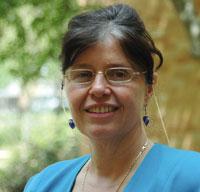
Speeding up Literacy ― Some Insights from Cognitive Neuroscience
The vast majority of the world’s languages are spelled regularly; words are written as they sound. Students therefore can learn basic reading in a year or less. But the spelling of English has complex patterns and many irregularities. Teaching the various patterns takes three to four years.
Learning to read can be a bigger problem for children who speak dialects derived from English, such as those in the Caribbean and countries including Sierra Leone, Liberia and the Nigerian Delta. Mapping the sounds of dialects to the already complex English spelling becomes a guessing game and results in large-scale illiteracy. While some countries of the Caribbean can afford to spend more on reading remedies, African and Oceanian countries cannot.
For this reason, there have been attempts to write English dialects phonetically, so that children, using a consistent spelling system, could be taught to read in a year or less. French-derived Creoles, such as those of Haiti or St. Lucia in the Caribbean, were written phonetically decades ago. Perhaps, the most prominent example for English is the Jamaican patois (patwa). Efforts to create consistent spelling have been refined by Prof. Hubert Devonish, Jamaican language unit, University of the West Indies (hubert.devonish@uwimona.edu.jm, http://www.mona.uwi.edu/dllp/jlu/index.htm).
In a phonetically-based program, literacy could be much more efficient, as grade one students would learn to read their dialect letter by letter. The goal should be to get all students to identify the letters in milliseconds. This ought to be possible in fewer than 100 lessons, even considering absenteeism and lesson reviews. In this approach, students would also be concurrently learning spoken standard English.
After becoming fluent readers, perhaps in the middle of grade two, students would receive “bridge” training in one to two years in standard English spelling. Using this approach, students should be able to transition with less effort into reading in standard English. This form of language learning can be culturally sensitive, as Creole dialects have traditionally been identified with low social status. (http://newsandviewsbydjmillerja.wordpress.com/2012/09/ 12/the-patoispatwa-wars/).
Also, there are spelling considerations that must be further researched. For example, efforts must be made to write Creoles so as to maximize contrasts with standard English, while facilitating common spelling patterns. However, the potential is significant. This method could be piloted in counties where Creoles are spoken in hopes of giving students the same advantage as those speakers of consistently written languages using the same alphabet.

